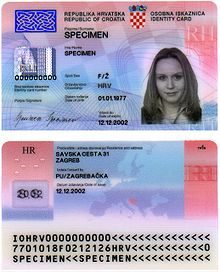- Croatian identity card
-
Croatian identity card (Croatian: Osobna iskaznica) is a compulsory identity document issued in Croatia. Every Croatian citizen who is resident in Croatia over the age of 15 can have an ID card, and all persons over the age of 16 must have an Identity Card issued by the police on behalf of the Ministry of the Interior.[1]
Contents
Physical appearance
Similar to a credit card, the identity card is plastic and rectangular in shape, 86 × 54 millimeters in size. On the left side is a hologram, on the right side is the photograph of the bearer. On the top edge of the card, the name of Republic of Croatia available in two languages, Croatian and English (REPUBLIKA HRVATSKA / REPUBLIC OF CROATIA), below the name of the card is available in the same two languages (OSOBNA ISKAZNICA / IDENTITY CARD).[1]
Printed data
The descriptions of the fields are printed in Croatian and English.
- Front side:
- Surname
- Name
- Sex
- Identity Card Number
- Citizenship
- Signature
- Date of birth
- Date of expiry
- Back side:
- Residence and address
- Issued by
- Date of issue
- Machine-readable data
Fines
Persons over the age of 16, and who do not have a valid ID, can pay a fine from 1,500 up to 2,500 kuna. Failure to show a valid ID to a police officer in a public place can result a fine of 100 kuna.[2]
International travel
The card can be used for traveling to and staying in countries that have special agreements with Croatian Government without the need for a passport. Croatian citizens are allowed to cross the border with ID card only (passport not obligatory):
For crossing the Schengen border into Hungary, Italy (also in San Marino and Vatican City) or Slovenia with an ID card and an evidention card that is issued by Croatian police at border exit control. Police authorities of Hungary, Italy or Slovenia will then stamp the evidention card both on entry and on exit. Croatian citizens, however, are not allowed to enter any other Schengen agreement countries without a valid passport and entry stamp, though they are allowed to travel between Hungary, Italy and Slovenia.[5]
See also
References
- ^ Zakon o osobnoj iskaznici (Croatian)
- ^ Zakon o osobnoj iskaznici (Croatian)
- ^ Bosnia and Herzegovina Visa requirements overview
- ^ Montenegro Visa requirements overview
- ^ See Schengen and Slovenia / Third-country nationals at "Republic of Slovenia: Ministry of the Interior: FAQ about Schengen" (in English). Archived from the original on 2008-02-03. http://web.archive.org/web/20080203024747/http://www.mnz.gov.si/en/pogosta_vprasanja/faq_about_schengen/. Retrieved 2008-03-02..
External links
National Identity cards By continent AfricaAsiaPeople's Republic of China (Hong Kong SAR • Macau SAR) • India • Indonesia • Iran • Israel • Malaysia • Pakistan • Philippines • Saudi Arabia • Singapore • Sri Lanka • South Korea • Republic of China (Taiwan)1OceaniaEuropeAlbania • Austria • Belgium • Bosnia and Herzegovina • Bulgaria • Croatia • Cyprus • Czech Republic • Estonia • Finland • France • Germany • Gibraltar • Hungary • Italy • Lithuania • Macedonia • Malta • Moldova • Montenegro • Netherlands (BES) • Poland • Portugal • Romania • Serbia (Kosovo1) • Slovakia • Slovenia • Spain • Sweden • SwitzerlandNorth AmericaSouth AmericaNotes 1 Partially unrecognised and thus unclassified by the United Nations geoscheme. It is listed following the member state the UN categorises it under.
Biometric identity cards ( ) are indicated in italics.Categories:
) are indicated in italics.Categories:- Croatian law
- National identity cards by country
- Front side:
Wikimedia Foundation. 2010.

